Please choose your country or region so we can show you the most relevant content.
It looks like you are in United States? Accept
Africa
- Algeria
- Angola
- Benin
- Botswana
- Burkina Faso
- Burundi
- Cabo Verde
- Cameroon
- Central African Republic
- Chad
- Comoros
- Congo
- Côte d'Ivoire
- Djibouti
- DR Congo
- Equatorial Guinea
- Eritrea
- Eswatini
- Ethiopia
- Gabon
- Gambia
- Ghana
- Guinea
- Guinea-Bissau
- Kenya
- Lesotho
- Liberia
Asia
Australasia
Europe
- Albania
- Andorra
- Austria
- Belarus
- Belgium
- Bosnia and Herzegovina
- Bulgaria
- Croatia
- Czechia
- Denmark
- Estonia
- Finland
- France
- Germany
- Greece
- Greenland
- Holy See
- Hungary
- Iceland
- Ireland
- Italy
- Latvia
- Liechtenstein
- Lithuania
North America
Middle East
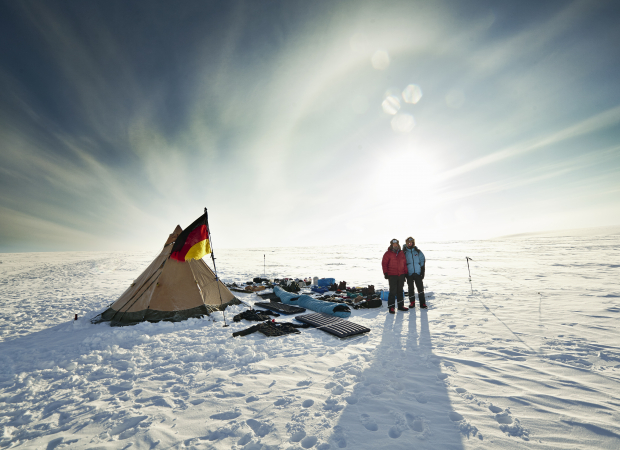
Adventure Expedition Polar Arctic Extreme climate Winter camping
Spitzbergen
27 Nov 2013
Over a three-week period during March and April this year, Eric Folz and Mike Fuchs hauled sleds of equipment some 500 Km through the frozen landscapes of Spitzbergen. Meticulously planned and executed, and in temperatures down to minus 38 degrees, they quickly adapted to the world of cold. Here, in a guest post for our Blog, is Mike’s own account.
—o—
Position N79°17.107, E16°01.550. We’re on our way!
The two snowmobiles had set off back south early in the morning. Now we were completely alone. Within a circumference of 300 kilometres, there was not a single house or anything else that could be of any help to us. Step by step, we packed our expedition sleds, carefully stowing away each item in the order that we would need it: tent, tea, cameras…
After skiing for a few kilometres, Eric and I named the fjord where we had been dropped off ”Bear Fjord”. We had crossed at least thirty bear tracks as we headed north. It was rather scary and we immediately began thinking about how and where we would set up our next camp. We had actually given a lot of thought to a bear fence and had even made a sketch on two occasions but you can never really know what goes inside a bear’s mind.
It takes at least 45 minutes to put up a fence so we were very glad that the tent only takes about five minutes to erect, even in a storm or on hard ground. In recent years, I have tested many types of tents — geodesic tents, tunnel tents, big tents, light tents, small tents — but I have never been 100 % satisfied with any of them. But with Safir 5, I have found a tent that can cope with all the requirements of an Arctic expedition: quick to erect and take down, sturdy in the toughest of snow storms and large enough to be able to spend three days in, with all the baggage and other stuff, if you have to wait for better weather. Since we had chosen not to have an inner floor, we could dig a big hole just inside the entrance which gave us even more space inside the tent. Perfect!
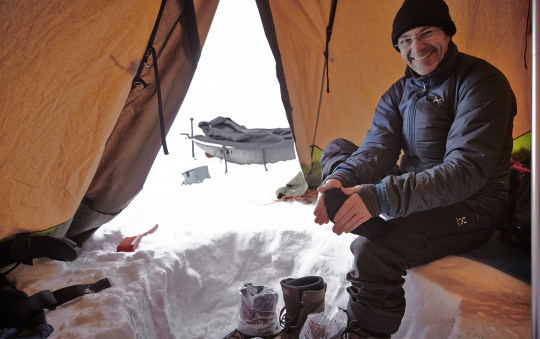 |
| Mike Fuchs Gets organised for the night on the arctic snow inside the Safir with no floor! |
So this was our first night among the polar bears. Did we really dare to cook food or would it be better to refrain from the wonderful smells of a moose stew so as not to attract our four-legged friends? No, we decided we had to cook some food since we were completely exhausted after our first 15 kilometres, pulling 65 kilos of baggage behind us in our stylish expedition sleds.
The last rays of sun did not disappear until about 23.30, leaving us on our second night with a temperature of minus 32 — and getting colder.
We felt safe with our bear fence and our rifle positioned between our air mattresses and we soon fell asleep, warm and cosy in our thick sleeping bags. If only we hadn’t drunk so much tea during the evening…
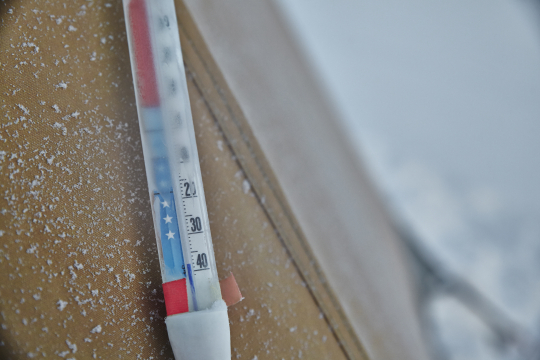
The temperature dropped to minus 38. That sort of cold is not particularly pleasant and your nose hurts when you breathe. Inside our sleeping bags, we were wearing socks, long and thick Merino wool underwear, a thick balaclava and a hat. A layer of ice formed in no time in front of our mouths. The silk inner sleeping bag and the moisture barrier added a few degrees of warmth to the expedition sleeping bag which is designed for use in minus 40. We had asked Nahanny to specially adapt our sleeping bags and had ordered a few extra features: more down filling at the foot end and extra waterproof outer material with a membrane.
It’s not much fun having to go out at four in the morning even if there’s no wind. But was it really still nighttime? The sun had probably been on the horizon again for hours but it didn’t matter; we slept a bit longer.
This was our routine for the next three weeks: we got up at seven, made some tea and prepared our müsli, discussed the day’s route and packed up camp. Every morning, we were on the move just after nine o’clock.
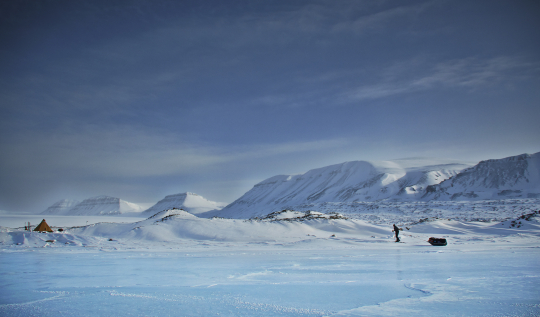
We couldn’t get over how varied the landscape of Spitsbergen is. Fjords, steep mountains, smooth-topped hills, glaciers that slowly float to the sea, huge, flat, elevated table-lands that could have housed large towns, and constantly changing weather. During our preparations for the expedition, we had had intense discussions about which route to take and we had listed many alternative routes including potentially breaking off the expedition. Then we went back south, from the most northerly point of the islands to Spitsbergen’s only settlement, Longyearbyen.
How do you dress when the temperature is way below zero for weeks on end? When you go on trips in the fells, there are plenty of opportunities to dry out your equipment in a cottage and spend a night in warmth. Here, on a glacier plateau in the middle of the Arctic, there is nothing except a few ”sastrugi” (wind-eroded, hardpacked snow formed like frozen waves). When it comes to underwear, my first choice is Merino wool. Then I put on a jumper and trousers made of fleece, a thin down jacket, liners (inner gloves), hardshell trousers, a thick down jacket which goes down to my thighs, thick Canada boots which keep your feet warm even in minus 70, lambskin gloves, a balaclava, a leather hat and — when it’s extremely cold — yet another big down parkas on top of all that. When you add up the value of all these high-quality products, you soon reach the cost of half a small car! But this is an investment in products that can be used for many years and which won’t let you down when you really need them.
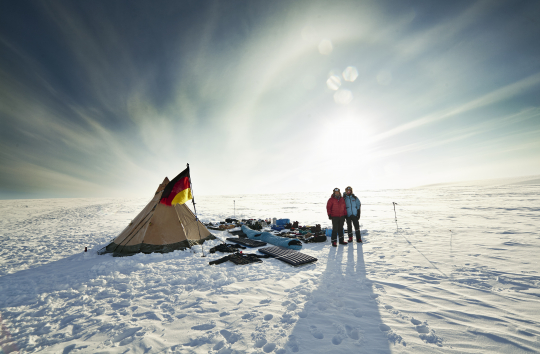
Strangely enough, after our first all-over wash, standing outside the tent when there was no wind, we didn’t think it was as cold as it had been before. After a few days, our bodies adapted to the cold and they burned food so efficiently that we couldn’t get food inside us sufficiently fast. Before, we had shivered from the cold. It was still very cold but the shivering had stopped and our backs were less tense. We were always quick to put our hands back in our jacket pockets or between our thighs after they had done the job in question. We kept moving by stamping a simple three-beat pattern with our feet.
Every evening, we read weather forecasts sent to our iPad via satellite mail. At the end of the first week, the barometer indicated rapidly falling air pressure so we were prepared for storms every day. As is the case in all polar regions, Spitsbergen has little precipitation and if there is snowfall, it is soon blown away again by the wind. Nevertheless, practically everywhere there was enough snow for our long snow pegs so that we could secure the tent even more firmly, in readiness for the approaching storm. As an extra precaution, we built a small wall out of snow to shelter from the prevailing winds. As we set up camp, the wind increased from 5 to 7.
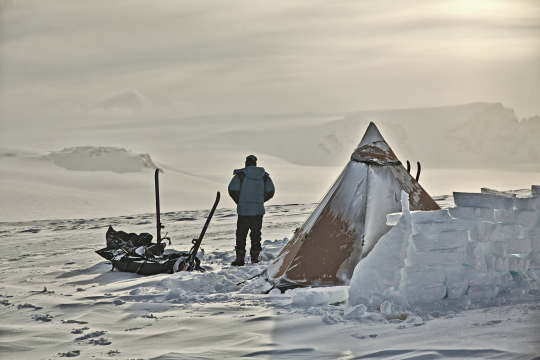
Outside, the wind was swirling the snow around so much, you could hardly see your feet. But inside the tent, we were just fine, enjoying our soup and chocolate pudding. The peacefulness inside the tent was wonderful. Previously, I have had so many nights when I have stayed awake all night, either because of the noise or because I’ve been afraid the tent canvas wouldn’t be able to withstand the force of the wind.
It’s true we lost three days because of that severe storm but meanwhile we were able to do some small repairs and make some modifications to our gloves, camping stove and communication equipment. Our tired legs were also happy to rest after climbing more than 3 000 metres in altitude over the last eight days. Because of the bitter cold, the snow was very rough and after precipitation in the form of ice fog, it felt like sandpaper. Pulling the heavy expedition sleds upwards took a lot of effort and sweat.
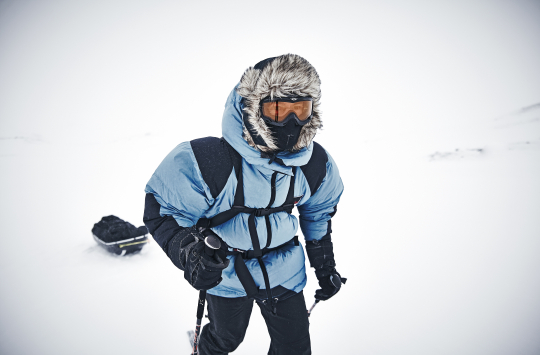
But sweating is prohibited in the Arctic! You mustn’t sweat on ”normal” long winter trips either. We avoided sweating by moving slowly and by adapting our clothes to suit the temperature. That’s why on a sunny day, I will ski in thin skiing underwear even though it’s minus 17!
Sometimes something may still get damp and the only way to dry it is to place it close to your body. We dried gloves and socks by wearing them between our jacket and fleece jumper when cooking our evening meal. By doing that, they were usually completely dry one day later. It’s true that after a fortnight, there were some very interesting smells but it didn’t take long for the cold to dispel them.
One night, the wind chill factor meant the temperature was well under minus 50. Would our cameras and batteries cope with that? At this point, the solar panel and the generator were running day and night and every three hours they had to be warmed up with the help of a hot water bottle. This was something we had not predicted and it caused us extra work and cold fingers.
On my trips, there are always some things that I try out or take with me in addition to the thing that I know works well. This time it was lambskin gloves and “mukluks” (soft boots for a cold climate). These items were based on an old principle that is still unbeaten. There is no high-tech glove that can give me as much pleasure and warm fingers as fast as a lambskin glove. My mukluks gave my feet the relief they needed after the ski bindings had been hard on them for five to twelve hours.
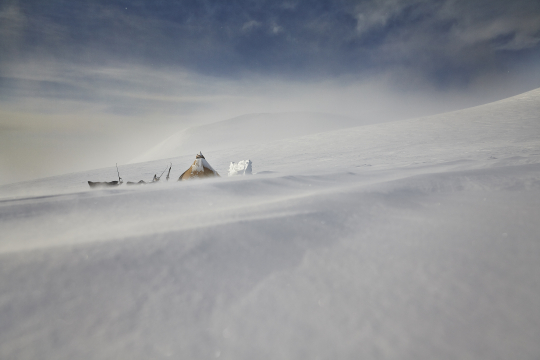
Several days later:
1 200 metres above sea level, in the middle of the Arctic. It’s minus 22, no wind but sunny and a deep-blue sky. Could anything be more beautiful?
At last, we could devote time to our still and film cameras and we eagerly filled gigabyte after gigabyte. We were also able to use our film drone (remote-controlled, airborne camera). With fully charged batteries, it shot up 300 metres into the sky and filmed us from above, with skis and expedition sleds in the middle of nowhere. I could hardly wait to see the pictures on the screen. The extra three kilos that we had to pull in order to take the drone with us were definitely worth it. We are extremely proud of these film sequences; after all, we were not just doing this for pleasure!
On this type of expedition, you must consider carefully every kilo that you are going to have to pull week after week. Nevertheless, we did allow ourselves a little luxury. We took a loudspeaker and an MP3 with us and every evening, we could hear it filling the white desert with our favourite music over and over again. It was quite funny how you would go to the toilet and then on the way back to the tent, hear the music and think, there’s a big party going on in there!
Much of the equipment has been carefully designed for low sub-zero temperatures and has been manufactured to withstand such conditions. For instance, we’ve known for years that our ski bindings function very well so we can concentrate on the things that keep taking us back to the cold: confidence, adventure and a search for challenges. And there are plenty of challenges since it’s impossible to plan everything. That’s when it’s good to have perfect equipment, like our Nordic tipi Safir.
After 22 days and a total of 500 kilometres, on 19 April we suddenly arrived at Longyearbyen, a little town with 1 800 inhabitants. That is the equivalent of almost half of Spitsbergen’s population of polar bears. There was no indication at all that there, behind the mountain, there is a settlement. From one moment to the next, we suddenly found ourselves in the middle of the town — and a bit sad that our expedition had already come to an end.
Equipment that we warmly recommend for your next winter trip:
Long Woolpower 400 underwear and other Woolpower base layer products
Sleeping bag and winter jacket, Nahanny Extrem
Lambskin gloves
Canada boots and Mukluks
Weleda Wind & Weather Cream (contains no water and can be used in minus 30)
Plenty of nuts and thin bars of chocolate (they thaw faster)
—o—
Related blog posts
It was the first day of the trip, adventurer Mike Fuchs and his friend Eric Folz had just a couple of hours before been dropped off as far north as they could possibly come in Svalbard when they saw them. Two polar bears, one mother and its cub. A situation that could become deadly if the bears decided to have a closer look on their new visitors.
“I know how protective the mothers can be of their cubs. We had to set up our camp in a place that provided a good overview of the location so we could spend the night bear watching. It was both a scary feeling seeing them so early into our trip, but it was also very fascinating”, says Mike Fuchs.
Wouldn't it be exciting to spend the night right in the middle of a zoo? – That is exactly what you can do at Skånes Djurpark, a wildlife park in southern Sweden. At their campsite, Camp Oak, you stay in the park after it closes and will make yourself at home in a Nordic tipi from Tentipi. When the night comes you might just fall asleep to the wolves’ howls.
Skånes Djurpark is a Wildlife Park with a long history, it dates back to 1952. It focuses on animals from the Nordic area and has always lived by the ruling with “no animals in cages”. The animals live in large paddocks that recreates the animals’ natural environments.
Lennart Pittja is a Sámi entrepreneur with a mission: with his world-renowned eco-tourism company he wants to spread the knowledge about his people – the Sami, indigenous of northern Scandinavia and Russia. With over 20 years of experience as a wildlife guide and nature photographer in the arctic region he started Sápmi Nature Camp. Where his guests stay in Nordic tipis from Tentipi on his reindeer herding land outside of Gällivare, in northern Sweden.
At Sapmi Nature camp you can experience real winter, see the northern lights, eat traditional Sami food, and have a cultural exchange in a genuine atmosphere. The scenic location has gained attraction from around the world. In 2017 it was listed by National Geographic as one of the top 21 places in the world to visit if you care about the planet.
Prepare before setting out for winter camping. Here are nine tips and tricks from Tentipi about what you need to think of before you go: the right tent for winter camping, how to pack the snow, comfort in snow, which tent pegs to use, where to pitch the tent, about snow weight, what heat sources can be combined with the tent, how to make a fire safely and other equipment.
Choose tents according to occasion, different tent types work differently at winter camping. When it’s icy, the tent needs to be more robust than a tent which is exclusively used in summer. The tent frame needs to withstand a certain amount of snow and functional ventilation is important. If you want to use a heat source, for example a fireplace or a stove, the tent needs to have ventilation openings both at ground level and at the top. Without a heat source, a smaller tent is preferable, as it heats up faster when the air volume is smaller.
A tent from Tentipi is a Nordic tipi and the tent has eight or nine sides, if it is not the smallest that has six sides. In the smallest tent you can stand straight if you are less than 160 centimetres long and in the largest you can get together several thousand people. The tent is versatile in more ways. Continue to read to see why these tents are so flexible and adaptable. This blog post is about the smaller tents in Tentipi's range, tents used by adventurers, families, hikers and others who want to live close to nature for a shorter or longer period of time.
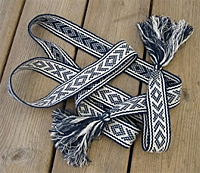
Sami cultural band
The Sami are a nomadic, indigenous people in northern Scandinavia. They are known as the people of the sun and the wind. Some Sami still work as reindeer-keepers. Traditional Sami clothes are decorated with colourful, woven bands and bands like this used as shoelaces.
Use fire safely!
Use fire safely!
Tentipi® Nordic tipis are designed to be used with an open fire or stove; it is this feature that makes them a home from home in all weather conditions. But please check local regulations, read and understand the instructions provided, and make sure you are fully competent to deal with the risks involved, before striking that match.
Tentipi® is a registered trademark of Tentipi AB












